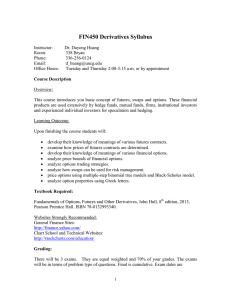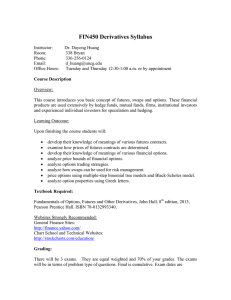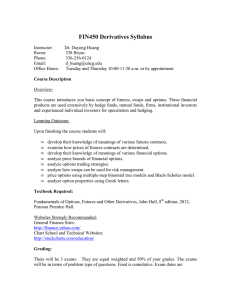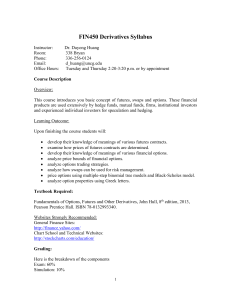Seven Secrets to Crude Oil Futures Trading Success
advertisement
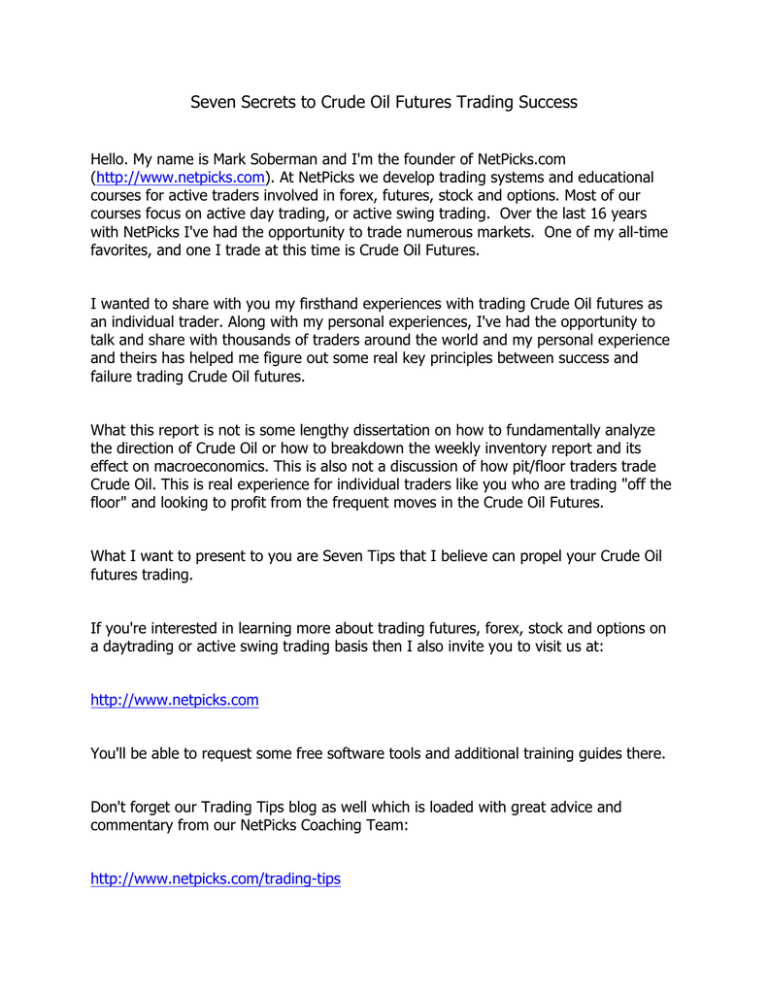
Seven Secrets to Crude Oil Futures Trading Success Hello. My name is Mark Soberman and I'm the founder of NetPicks.com (http://www.netpicks.com). At NetPicks we develop trading systems and educational courses for active traders involved in forex, futures, stock and options. Most of our courses focus on active day trading, or active swing trading. Over the last 16 years with NetPicks I've had the opportunity to trade numerous markets. One of my all-time favorites, and one I trade at this time is Crude Oil Futures. I wanted to share with you my firsthand experiences with trading Crude Oil futures as an individual trader. Along with my personal experiences, I've had the opportunity to talk and share with thousands of traders around the world and my personal experience and theirs has helped me figure out some real key principles between success and failure trading Crude Oil futures. What this report is not is some lengthy dissertation on how to fundamentally analyze the direction of Crude Oil or how to breakdown the weekly inventory report and its effect on macroeconomics. This is also not a discussion of how pit/floor traders trade Crude Oil. This is real experience for individual traders like you who are trading "off the floor" and looking to profit from the frequent moves in the Crude Oil Futures. What I want to present to you are Seven Tips that I believe can propel your Crude Oil futures trading. If you're interested in learning more about trading futures, forex, stock and options on a daytrading or active swing trading basis then I also invite you to visit us at: http://www.netpicks.com You'll be able to request some free software tools and additional training guides there. Don't forget our Trading Tips blog as well which is loaded with great advice and commentary from our NetPicks Coaching Team: http://www.netpicks.com/trading-tips The Seven Secrets Secret #1: Trade Prime Time Only Crude oil futures trade a lot of hours. Do you want to trade Sunday through Friday starting 6:00pm Sunday night? I know I don't. You can see from the below chart from the CME (Chicago Mercantile Exchange) that the hours you can in theory trade the Crude Oil futures is extensive. However, I'm going to suggest you ONLY trade these hours: 8:50am EST (New York Time) - 10:30am EST. So just over 1.5 hours maximum. In fact, feel free to even use 9:00am EST to 10:30am EST as the 8:50 - 9:00 range is the lead up to the Open Outcry pit trading though I've found it's a good time to trade. In literally hundreds, make that thousands of trades and tests I just continue to go back to these times as the best for daytrading. That should come as some relief -- focus on 1.5 hours and throw away the rest. You do that and you'll save yourself a lot of work, stress and hassle. And, I believe your best results will come during this time. Next, be careful from 9:00am - 9:01am EST. Since the pit trading is just opening you can easily get whipsawed and stopped out if you enter a trade during that 1 minute period. I personally usually step aside and avoid a new entry - it's only one minute stand up, stretch, then you're ready to go and less likely to get caught in whipsaw. That's it. Trade "Prime Time" and leave the rest to everyone else. You can do that right? Product Symbol CL Venue CME Globex, CME ClearPort, Open Outcry (New York) Hours (All Times are New CME Globex Sunday - Friday 6:00 p.m. - 5:15 p.m. New York time/ET (5:00 p.m. - 4:15 p.m. Chicago Time/CT) with a 45-minute break each day beginning at 5:15 p.m. (4:15 p.m. CT) York Time/ET) CME ClearPort Sunday – Friday 6:00 p.m. – 5:15 p.m. (5:00 p.m. – 4:15 p.m. Chicago Time/CT) with a 45-minute break each day beginning at 5:15 p.m. (4:15 p.m. CT) Open Outcry Monday – Friday 9:00 AM to 2:30 PM (8:00 AM to 1:30 PM CT) Contract Unit 1,000 barrels Price Quotation U.S. Dollars and Cents per barrel Minimum Fluctuation $0.01per barrel Secret #2: Weekly Inventory Report As you might know, or you should, there is a major Crude Oil report - the Weekly Inventory report. Most weeks it will fall on Wednesday and get released exactly at 10:30am EST. But, not every week. When there's a holiday it typically gets delayed to Thursday @ 11:00am EST (after the Natural Gas Inventory report which happens to usually be released 10:30am EST on Thursday when Crude gets pushed to Thursday due to a holiday) Make sure you don't get caught and mess up the day/time. Here's a clipping from a website: http://www.forexfactory.com This website has a nicely organized and always updated, including future weeks, Economic Calendar. In fact when I pulled this I noticed the week before this listing for September 14th was in a holiday week and sure enough, the report was Thursday not Wednesday in that prior week. Wed Sep 14 2:30am AUD RBA Annual Report 4:30am GBP Claimant Count Change 4:30am GBP Average Earnings Index 3m/y 4:30am GBP Unemployment Rate 5:00am EUR Industrial Production m/m Tentative GBP Inflation Report Hearings 8:30am CAD New Motor Vehicle Sales m/m 8:30am USD Core Retail Sales m/m 8:30am USD PPI m/m 8:30am USD Retail Sales m/m 8:30am USD Core PPI m/m 10:00am USD Business Inventories m/m 10:30am USD 5:00pm NZD Crude Oil Inventories Official Cash Rate Ok, now you know exactly when the report occurs so now let's talk why this is important. In a few years of active Crude Oil futures trading I have found that trading on report day from 8:50am EST - 10:30am EST is not nearly as good as all other days. Typically in fact I've found one out of three or one out of four weeks is downright awful and an epic struggle filled with losses. So while my trading might be wonderful Monday, Tuesday, Thursday and Friday during 8:50am - 10:30am -- it is another story on Inventory Report day. Not to say some days aren't perfect on report day. They are. But, I find it much more unpredictable. My suggestion? On report day (usually Wednesday, sometimes Thursday as outline) do NOT trade from 8:50am - 10:30am EST. Then, yes, you can trade it but wait until 10:32am EST and start taking your trades. Give it 2 minutes to regain its composure, as the market is basically un-tradeable right at the release. But, in 2 minutes time order gets restored, and while it might be active it can be traded. In fact, this is one of my absolute favorite times to trade -- after the report. However, I have a hard stop at 11:30am EST on report days -- and usually the activity is such that objectives should be reached well before that time. Secret #3 - What Size Profit Targets Work? In my experience, if you want to daytrade the Crude Oil futures with consistent success your profit targets should be in the 0.15 to 0.20 range. I have found that this falls well within the comfortable swings up and down that this market goes through. 0.15 = $150 on the full sized contract ($10/tick or 0.01) and 0.20 = $200 so that's plenty of profit potential but it's not going to make outsized demands on your trading strategy like if you were shooting for 0.30, 0.40, 0.50. Not to say there aren't big moves like that. Plenty of times I've seen it rally $1.00 or more but we're trying to have a plan that will work consistently and provide you profits. Later, I'll give you some ideas on how to trail for the bigger moves but in the meantime this is a fixed target range that works well. Now personally, I am not a fan at this time of trading the e-Mini version of the Crude Oil Futures. In my experience the best trading is on the regular, full sized contract. It's where all the volume is and it trades in smaller increments than the emini: Code QM Venue CME Globex, CME ClearPort, Open Outcry (New York) Hours (All Times are New York Time/ET) CME Globex: Sunday - Friday 6:00 p.m. - 5:15 p.m. (5:00 p.m. - 4:15 p.m. Chicago Time/CT) with a 45-minute break each day beginning at 5:15 p.m. (4:15 p.m. CT) Open Outcry: Monday - Friday 9:00 AM to 2:30 PM (8:00 AM to 1:30 PM CT) CME ClearPort: Sunday - Friday 6:00 p.m. - 5:15 p.m. (5:00 p.m. - 4:15 p.m. Chicago Time/CT) with a 45-minute break each day beginning at 5:15 p.m. (4:15 p.m. CT) Contract Unit 500 barrels. Pricing Quotation U.S. dollars and cents per barrel. Minimum Fluctuation $0.025 per barrel Notice it moves in 0.025 increments on the Mini vs. 0.01 on the full sized. To me that means I'm just giving up profit with a less precise entry on the Mini. In addition, the volume when I'm looking in real-time as I write this is just 4,000 contracts on the mini "QM". At the same exact time the full sized "CL" it is 140,000. You get the idea. Go where the action is and liquidity. Just be sure you have enough in your margin account. You can trade this market with $5,000 but you'll likely be risking more than 2% of your account with each day trade and if that makes you uncomfortable you'll want to start with a higher starting balance. Secret #4: Precision Trade Placement Ok, so now you know which Crude Oil futures contract to trade, what time to trade it, when to step aside and what type of targets to expect as a daytrader. You now need to know how to place your trades and get the best fills. This is what I've found. I place all my entries with STOP-LIMIT orders. For example, if the market is trading at 88.44 and I want to enter a buy at 88.56 based on my trading strategy (you have a strategy right? If not find out more at http://www.netpicks.com) then I'll place that order as a Buy Stop-Limit 88.56. The reason I do this? I have found you can invite a lot of slippage in some cases when you place a straight Buy-Stop @88.56. Now there is a downside to this type of Stop-Limit - you may not get filled. It can be frustrating to have a perfect set-up only to find your precise stop-limit got jumped over and then the move advances to target in seconds -- but not with you onboard. Boo-hoo - that hurts. It does. So how do we solve this? I place an order with my broker (Interactive Brokers in my case) that allows for one tick of leeway. I tell it I want a Buy Stop-Limit at 88.56 but I will take 88.57. This should be something you have available with your broker - you're basically saying: Buy Stop @88.56 with a Max Limit at 88.57. You'll certainly have a good chance of getting 88.56 with no slippage - worst case you get filled with just one tick slippage. By doing this, I've found at least 60% of the time I have no slippage. The other 40% I have just the one tick slippage. And, I'd say it's rare that I miss a fill altogether. I have to warn you that it's still possible you'll miss a trade but I've gone a month without missing one and if I added up all the slippage I'd probably have by not doing this, I can handle an occasional missed trade. Now, for profit targets mine all go in as straight Limit orders. I will say that about 90% of the time if the market moves to the Limit Price I get filled. Just realize on occasion you won't get picked up on the first move to your limit price. That can be frustrating and stressful but I've found the overwhelming majority of the time I will get picked up even on the second attempt. What you'll want to do though is have a plan in mind that what happens if the market reaches that Limit Price but you don't get that fill. Personally I'll raise my stop and make sure that worst case I grab at least a few ticks profit in case it truly reverses on me. "Trade for Profit" should be your mantra so don't let it free-fall against you. Protective stops? In that case I do NOT use Stop Limits. My stop has to take me out the last thing I need is a trade that has gone against me and I get greedy with a Stop Limit on exit and it leapfrogs over and I'm staring down a big loss. I'm ok with slippage if it happens on a protective stop. Usually I don't have any but regardless I know I'll be out. Trade Secret #5 -- Range Bars? Renko Bars? Tick Bars? What is this Range Bar I talk of? You thought it was all about just throwing up a 5minute time interval chart and you'd be off to the races right? Well it's certainly easier to think of markets charting on a time interval chart. 1 minute, 2, minute, 3 minute, 5 minute, etc... We all know how to tell time so that fits nicely in our minds as the way to chart and trade. But, I'm going to tell you I have been far more successful over the years in my daytrading when I use non-traditional charting intervals and that means not using time intervals. My favorite for crude oil? Typically either Range Bars or Tick Bars. Now, not every charting platform will have these options -- if yours doesn't how about chucking it and getting a platform that actually gives you the power and features you need? You're about to risk thousands in the markets and you don't want to do that with inferior tools. You're setting yourself up for losses before you even start. Now, what's a Range Bar? Here's a quick example of what a Range Bar chart would look like: In this example, every bar is the exact same size. That’s what a Range Bar is. So assume in this example each of these bars is 0.10 or 10 ticks in size. Every time the market moves up and down and goes a distance of 10 ticks – a new bar will form. Now, it doesn’t have to be 0.10 – you can set it to be 0.05 (5 ticks) or 0.06 (6 ticks) and then the chart will plot and every bar will be identical size. Think about why this can work for you. If the market is on the move quickly, you’ll get a number of bars formed and your system/technical indicators will be responding quickly to the move and getting you trade set-ups. You want that when it’s moving. However, if the market is undecided and churning in a range it will typically plot fewer bars and your system/indicators are likely to be cranking out less trades and therefore getting you into less trouble. Time intervals are not that smart – no matter what a 1 minute bar is going to plot every 1 minute – regardless of whether the market is moving or not. And many times time interval bars are very slow to respond to fast moves. So you lag the big moves, and then overtrade the slow moves. I find myself typically working with 0.05, 0.06 or 0.10 range bars of course depending upon the strategy/system I’m using. If you have one that puts out a LOT of trades you’ll need to consider 0.10. If during Prime Time it is only putting out a handful you might need to go with a quicker chart or the 0.05/0.06. A little experimenting will show you the way. What about Tick Bars? A tick bar is formed by trade count. Every time there’s a trade in the Crude Oil futures a tick is formed. That’s an example of a 377 Tick chart. I like that setting for daytrading the Crude Oil futures if I’m using tick charts. Notice though that each bar is varying sizes unlike Range Bars. These will be whatever size it takes to get through in this example the 377 trades executing. However, it still is much more responsive than time intervals since active trading usually means the market is moving – and your system/indicators will respond. Slow markets with minimal movement have fewer trades and these tick bars will take longer to form – a nice filter in slow, choppy markets. I mentioned Renko bars above and while I like them in some markets, they tend to be advanced due to the fact that they do not plot every market price. Initially it’s not something I would focus on though there is some cool potential with Renko charts. Trade Secret #6 – Get In, Get Out, Get It Done Correctly I mentioned earlier having great tools. Daytrading Crude Oil futures requires that you can quickly place your order. The market is not going to wait for you to fumble around on your keyboard and clicking your mouse a bunch of times. You need to be able to determine your Buy or Sell Stop Limit price and enter that trade in a click. I can place my trade including the entry stop limit, and my profit target and stop in one click in about one second. This is critical. There are a lot of solutions and brokers out there so I’m going to suggest one solution where you can achieve this but you’re free to look at others. But, if you can do a one click trade entry order – that automatically places your stop and limit exit orders for you when you execute the entry then I believe you’ll struggle. My solution is using NinjaTrader (http://www.ninjatrader.com) and I use what’s called their SuperDom Trade Management: The above example is from their website and is actually the S&P e-Mini Futures but it works exactly the same way on Crude Oil Futures. You need to connect your NinjaTrader to a supported broker (such as Interactive Brokers) but once you do you can literally click on your desired entry price on the left side for a Buy Stop Limit or the right side for a Sell Stop Limit. It immediately gets placed in the market and also sets up your exit orders the moment that order gets filled. Need to change your entry price? Click one time drag and drop. Done. Sure, you could fumble around with your brokers platform and type in numbers. But you’ll make mistakes, stress out and miss winning trades. Trade Secret #7 – Trailing for the Home Run Trades First, I’m going to tell you that I highly suggest in the beginning you do not trail your trades. I suggest using just a fixed profit target and exiting there. You need to build your confidence, you need build your account and using something somewhat subjective like Trailing is not going to provide you that certainty that a fixed target will provide. With that said, at some point you might want to consider trailing a portion of your trades (I would only typically do this if I was trading 2+ contracts – exiting some at a fixed target) A suggestion is to consider a “Two Bar Stop” Here’s how it will work. Let’s assume you have bought the CL and you are long. I would typically only activate the “Two Bar Stop” trailing strategy once I have hit my fixed profit target. Each time a bar on your chart makes a new high, and a new low, you count back two “Lower Lows” and place your stop a tick or two below the low of that bar. All that is happening here is you can see that a bar has hit a new higher low/new higher high. That’s your qualifier. Then you just count back the next two Lower Lows – you can see there was one candle that had a high low – that doesn’t count – and then stop placed there. How about on a short? Once you have a candle that sets both a Lower Low and a Lower High than the previous you can count back two Higher Highs and place your stop there. That’s all there is to the “Two Bar Stop” and it’s very effective no matter what type of charting you’re doing – especially after you have hit a target and the market is moving strongly/favorably your way. You’ll catch some Home Runs but not give back much when it doesn’t work for you. Bonus Tip Secret Tip – The Power of Quitting What is the Power of Quitting or as we call it around here the POQ? It’s a concept that is quite simply but super powerful. Probably why it works. We approach every trading day with either a POQ=1 or a POQ=2 depending upon our Trade Plan. What this means is let’s say we are trading the Crude Oil Futures and using a POQ=2. We know we’re only going to trade from 8:50am (or 9:00am) – 10:30am EST. Our objective is to Quit our trading once we have 2 wins AND positive results. What I mean by this is if we go 2-0 – we’re done no matter what. If we go 2-1 we really should be positive – so we’re done no matter what. If we’re say 2-2 but down $50 we keep going – even though we have the qualifying 2 wins. The key here is two wins PLUS positive results. But, no matter what we always stop with our hard limit on time. If we’re not positive by 10:30am EST then that’s just how the day worked out. If we said POQ = 1 – we do that when we want to be in and out of a market quickly and go onto other things. It takes just the first winner to be done – I’ve been done in 30 seconds before on Crude Futures and it’s not that rare. However, if you have that one win (or more) then same – you still want it to be 1 win (or more) PLUS positive results. By following this simple plan you won’t be tempted to overtrade. You’ll have confidence knowing you can be done quickly many days and not make mistakes and have the stress that comes with frequent trading. There’s no need to just hand more commissions over to your broker. I’ve also found that the way the Crude Oil (and really all markets) trade is they get streaky. If I pick up a quick couple of winners, reality is probably going to hit and the market is going to consolidate and take back my gains. Or, if it starts poorly, almost always it will work itself out and I’ll get to a quitting point, even if it means a small gain – but I get to move on and trade it again the next day. Use the POQ in your daytrading – you’ll be glad you did. Thanks for reading the Seven Secrets to Crude Oil Futures Trading Success. We hope you got a lot out of it and will implement it into your trading. You’ll find a number of these concepts can actually be applied to other markets you might trade as well. To get more information on NetPicks including our trading systems, educational courses, free software and training simply visit us at: http://www.netpicks.com
